It was a good, relaxing weekend, and I got a fair amount done, but most importantly was able to relax in a way that I haven’t done much recently.
And yet, on this Monday morning, I am notably tired. I suppose I didn’t end up sleeping especially well, thinking of everything I’ll be working on over the week.
Tomorrow’s blog post for Somewhere in Japan, for example. I have no idea what I’ll write or what image I’ll use. During the course of the day today I’ll have to figure it out.
And there’s a ton of other stuff to do, which is just how life goes, of course. It gets tiring to think about when it’s this big, undifferentiated mass of things to do, but it’s a lot more manageable when you’ve got a good system for managing your tasks.
Which is why I’m going back to using a bullet journal system as of today.
I used a bullet journal for a long time to great effect, but got out of the habit during COVID when everything got all weird. Now that I’m back to working a normal job again and have a more regular schedule, it’s especially important to get back to managing my time more deliberately so that I can make the most of the free time I have before, during, and after work.
If you’re not familiar with it, a bullet journal (bujo for short) is a notebook combined with a method of note-taking and organization. Most often done in a notebook with a dot grid pattern, it can make use of check boxes, symbols, etc. It’s extremely customizable, and I think no two people do it exactly the same way.
Now, if you do an image search on “bullet journal,” you’re going to see all kinds of fancy spreads and twee lettering and other superfluous bullshit like that. I am not a fan. A bullet journal must be highly functional, above all else. To hell with making it pretty. I sincerely believe that integrating decorative elements into one’s bullet journal is simply a waste of time and counterproductive, but then I’m a bit of a curmudgeon on such things.
People are, of course, free to do it however they want.
I keep it extremely simple, though. I keep my schedule, to-dos, goals, etc organized in my bujo. In the past, I’ve also done my habit tracking there, and which I’ll resume on May 1 (I don’t like doing partial months, which is silly). Overall, I find it to be an extremely useful tool that helps me overcome the challenges of adult ADD while trying to transform my life (or just be productive in general).
It’s been a pretty transformational tool for me in the past, and I’m glad to be getting back to it. I think one reason it’s worked so well for me is that it’s a physical method. Doing things physically helps me focus, for one thing. It’s also persistent in a way that an app isn’t. It doesn’t need to be launched, it can never crash, doesn’t need to sync. All I need is a pen and the notebook and the system just plain works.
When I use a bujo system, I am very strict with myself in how I use it. Formatting is just so and should be consistent from page to page. The shorthand and symbols I use must also be consistent. The handwriting must be extremely neat. I need to make use of it every day, even on days off.
People who observe this sometimes remark on how disciplined I am and how they could never do it like that. The thing is, though, I have to be strict with myself or it doesn’t work at all. If I allow myself any leeway in this and a few other things in my life, they tend to fall apart quickly. And because I decide to do things in a very particular way and don’t give myself any other options, it’s actually pretty easy to stick to. 99% commitment is a hell of a lot harder to carry out than a full 100%, so I just commit to it fully and it mostly takes care of itself.
It’s not a system that works well for everyone, but I’ve found it to be extremely helpful, and I’m very glad to be getting back to it now.
